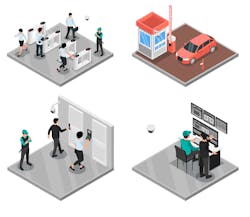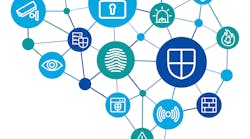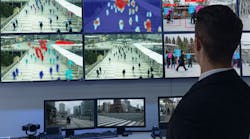The access control industry is poised to undergo a major transformation as artificial intelligence (AI) and advanced analytics are being increasingly adopted to improve security, efficiency, and effectiveness. Access control systems are vital in ensuring the security and integrity of people, physical spaces, data and resources. Integrating artificial intelligence (AI) and advanced analytics into access control systems will become a game-changer as technology evolves.
But for the past few decades, access control systems have been based on static rules and permissions, which determined attackers can easily bypass and they have limitations on flexibility, adaptability and scalability. So, the industry has been revising its thinking and adding features and functionality to address a changing environment and world. But even with added features like video surveillance, visitor management, and workplace solutions, many feel that future deployments will need a more proactive approach in the face of real-world threats. They are appreciated for forensic purposes but of little predictive value. And now comes artificial intelligence (AI) and advanced analytics, bringing significant value and efficacy to access control systems and better security in general.
AI-powered access control systems can learn and adapt to changing threats, making them much more difficult to breach while providing a heightened level of protection never imagined even by some industry veterans. And, for the first time, we are seeing proactive solutions with predictive capabilities that bridge the consumption gap and new thinking that has incentivized new and old players to challenge the status quo. Where we are going, if we are realistic and prudent in our approach, will redefine electronic security as we've known it.
This article explores how AI and advanced analytics bring value to access control systems by enhancing security, efficiency, and adaptability. We will also touch on the issues of security versus convenience, the value of contextualization, and how privacy, demographics and incentives will also have roles to play in the ever-morphing access control systems and the industry.
What are Artificial Intelligence and Advanced Analytics?
Artificial intelligence is a branch of computer science that deals with developing intelligent machines capable of performing tasks that usually require human intelligence, such as learning, problem-solving, and decision-making. Advanced analytics, on the other hand, involves using statistical algorithms and machine learning techniques to extract insights from large datasets. What does this have to do with access control systems? What does it do for us? How would we use it?
Rodney Thayer, Convergence Engineer at Smithee Solutions LLC, discussed these and other questions and his responses allowed me to break down the applicability of AI and Advanced Analytics.
"I definitely agree advanced analytics merits consideration for an access control system deployment. I'd rather think of it as an event correlation. I think of AI (or ML, if you want to use a less exotic label) as just this week's version of really good event correlation,” said Thayer. His responses suggest that there are events and data generated from within access control systems that, if they were not cost or time-prohibitive, correlation could have a positive and beneficial impact on the end-user's business outcomes and their security posture. Or, at a minimum, deliver benefits and value used elsewhere by the organization.The Benefits of AI and Advanced Analytics
By integrating AI and advanced analytics into access control systems, organizations can enjoy increased efficiencies, improved decision-making, new insights and opportunities, reduced costs, and enhanced user experience. More specifically, benefits will include:
Enhancing Security with AI and Advanced Analytics - AI and advanced analytics are being used to enhance security in many ways, including:
- Detection and prevention of unauthorized access: AI-powered facial recognition and biometric authentication can identify and authenticate users, while real-time anomaly detection using machine learning algorithms can detect suspicious activity.
- Threat detection and proactive response: Intelligent monitoring and behavior analysis can be used to identify potential threats. In contrast, predictive analytics can be used to identify potential security risks before they occur.
- Adaptive access control: Contextual access decisions can be made based on user behavior patterns, while dynamic risk assessment using AI algorithms can be used to dynamically adjust access control policies based on the risk level of a given situation.
- The most significant enhancement is adding surveillance video with AI and access control. It is a video that gives us our context.
Improving Efficiency through Automation - AI and advanced analytics can also be used to improve the efficiency of security operations by automating several tasks, including:
- Streamlining access requests and approval processes: Automated access provisioning and de-provisioning can streamline access and approval processes. In contrast, intelligent access request routing based on predefined rules can route requests to the appropriate approvers.
- Intelligent access management: AI-driven policy optimization and enforcement can be used to ensure that access policies are enforced consistently and efficiently. In contrast, automated access recertification and compliance checks can be used to ensure that user access is always up-to-date and compliant with regulations.
- Data-driven insights for resource optimization: Advanced analytics can be used to identify access usage patterns, which can be used to optimize resource allocation and reduce costs.
Enabling Adaptive and Scalable Access Control - AI and advanced analytics can also be used to enable adaptive and scalable access control by:
- Dynamic access control based on contextual factors: AI-powered contextual decision-making can make access control decisions based on various such as the user's location, the time of day, and the device they use.
- Integration with other security systems and data sources: AI and advanced analytics can be used to integrate with other security systems and data sources, which can be used to provide a more comprehensive view of the security landscape and make more informed access control decisions.
These are just a few ways that AI and advanced analytics enhance security and improve efficiency. We expect to see more innovative and impactful applications as these technologies evolve.
The Challenges of AI and Advanced Analytics
Data privacy and security
Data privacy and security are two of the biggest challenges of AI and advanced analytics. As these technologies mature, they can collect and analyze more individual data. How this data is used and protected will raise concerns.
It also raises questions about who will be the authority that governs this realm. Will we be self-governed? Will the industry step up to the plate? Or will we allow the government to institute GDPR-like regulations across the land?
There are several ways that AI and advanced analytics can be used to violate privacy. For example, AI-powered facial recognition systems can track individuals without their knowledge or consent. Additionally, AI-powered algorithms can be used to identify sensitive personal information from data sets.
It is important to ensure that AI and advanced analytics are used in a way that respects privacy and security. Strong data protection policies, encryption, and other security measures are needed to protect data. According to Thayer, “With great power comes great responsibility. Be careful to consider when your analytics start impacting the user's (or the business's) privacy. Warn well in advance before deploying AI-enhanced motion sensors outside the bathrooms."
Security vs. Privacy vs. Convenience
But at the same time, another conversation is changing the landscape. How do we address traditional security thinking regarding security vs. privacy or security vs. convenience? Which takes precedence? How do we serve both masters?
Lee Odess, CEO of The Access Control Executive Brief, offered these answers to the question above, saying: "Previously, it was only about security from our industry perspective, except when someone yelled the word' privacy. Then the discussion shifted, and privacy became the battle cry.
"There are two truths, new truths and old truths, and while we may wish for a binary conversation, it's really both. Security will always matter more in the security vs. convenience and the security vs. privacy discussions."
He added, "We need to show self-awareness and not feel threatened by change."
In other words, we must find a way to balance security, privacy, and convenience. Balancing these issues is a complex challenge, but it is one that we must address if we want to ensure that AI and advanced analytics are used responsibly.
Bias and discrimination
Another challenge of AI and advanced analytics is bias and discrimination. AI systems are trained on data sets, and if these data sets are biased, the AI systems will possess the same predisposition, which can lead to AI systems making unfair or discriminatory decisions.
Thayer suggested, “Trust but verify. Be sure to validate your AI solutions. Can it really tell the difference between - I came here straight from the gym and brought her tennis racket with me into the lobby - from - a person in the building with a potential weapon. Make sure your cat cannot badge in (unless you've issued it a badge of course.)”.
Adding, “Don't let the shiny new (AI/Analytics) toys distract you from attending to the basics of infrastructure security. Do not assume the PhDs who built your AI ever took a single Information Security class in college.”
It is important to address bias in AI systems. This can be done by using data sets that are less biased, by using more sophisticated algorithms, and by monitoring AI systems for signs of bias.
Cost reduction
The ability to reduce costs dramatically was pointed out by James Connor, Head of Corporate Engagements at Ambient.ai, when he said, “What matters to the C-Suite most is that the entire industry is investing in technologies, hardware, and software, hiring guard forces and building SOCs. But they end up paying people to clear tens of thousands of false alarms, daily. And at best, the industry might catch a crime or violation or other notable event by accident only when we go back to investigate. One company in Silicon Valley doesn’t even look at its alarms. They must deploy guards in 2023.”
If it becomes common knowledge that you are clearing alarms at $200K per seat, how will this sit with the C-Suite or the Board?” How does it feel if you were doing this now?
Regulation
The regulation of AI and advanced analytics is another challenge. There needs to be a clear regulatory framework for AI systems. This means that businesses need to be made aware of the rules for developing and deploying AI systems. The need for regulation is a barrier to adopting AI and advanced analytics. Some businesses may hesitate to adopt and implement these technologies if they are unsure of the rules.
It is important to develop a regulatory framework for AI systems. This framework should balance the need to protect consumers and businesses with the need to encourage innovation. While there may be uncertainty in the AI and advanced analytics industry as to how it will be regulated, at the same time, AI can help organizations improve compliance regulations such as HIPAA, GDPR, and PCI DSS, thus, protecting organizations from fines and penalties.
The Future of AI and Advanced Analytics.
How will AI and advanced analytics change the world?
- Personalizing our experiences: AI can be used to personalize our experiences by recommending access control products or services that will likely enhance our security and save time and money, and it can also help us find the things we are looking for more easily.
- Making our lives more efficient: AI can make our lives more efficient by automating tasks or providing us with insights we could not obtain independently to help us improve our decision-making.
What are the ethical implications of AI and advanced analytics?
- Bias and discrimination: AI systems are trained on data sets, and if these data sets are biased, the AI systems will be biased as well. This can lead to AI systems making unfair, discriminatory, or simply wrong decisions.
- The potential for job displacement: AI and advanced analytics have the potential to displace jobs as machines become capable of performing tasks that humans previously did. This could have a very serious impact on organizations, communities, and the economy.
How can we prepare for the future of AI and advanced analytics?
- Educating ourselves about AI and advanced analytics: We must understand how these technologies work and their potential implications. This will help us make informed decisions about using these technologies.
- Developing ethical guidelines for using AI and advanced analytics: We need to develop ethical guidelines for using AI and advanced analytics. This will help to ensure that these technologies are used responsibly.
- Investing in research and development: We need to invest in research and development to ensure that AI and advanced analytics are used for good. This will help ensure these technologies are used to solve problems and improve our lives.
Connor believes that video will be the biggest catalyst and factor influencing the acceptance and adoption of AI and advanced analytics in the access control and security industry
"What are the best technological ways to solve problems? Video might be the best. How does nature solve contextualizing the world, and understanding the world? Would you want to give up eyesight? It gives you the best way to understand your world. Technologically you would want to replicate that. How else would you distinguish between a door held open and a door-propped alarm?" said Conner.
The reality is that AI and advanced analytics implemented with the ability to use video to contextualize the world around us would seriously reduce costs, deliver more secure facilities by several orders of magnitude and reveal previously unimagined capabilities of problem-solving and decision-making to access control systems. It’s a game-changer and will put access control on steroids.





